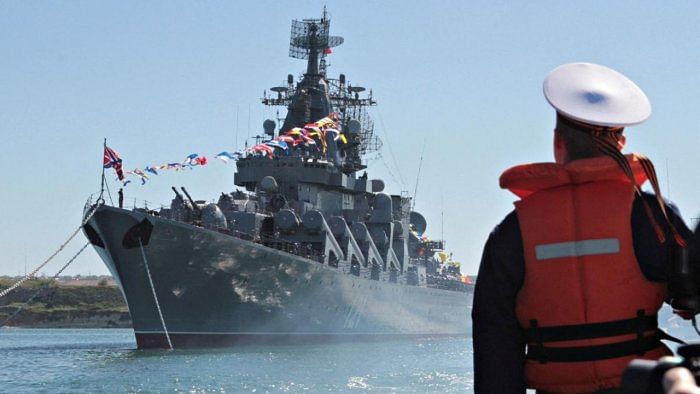
The missiles used to sink a warship from Russia’s Black Sea Fleet were built at home in Ukraine, as part of a coastal defense system designed to hide below enemy radar and evade counterattacks.
Russia’s Defense Ministry has maintained that an accidental fire broke out last week on the warship, the cruiser Moskva, resulting in ammunition explosions and ultimately the sinking of the ship. But US officials corroborated assertions by Ukraine’s military that the Moskva was taken down by two Ukrainian Neptune missiles.
The Neptune is a coastal defense missile designed to attack enemy warships up to 190 miles offshore, according to documents published by Luch, a Ukrainian state-owned arms developer. The weapon is launched from tubes mounted on the back of large trucks, which can fire them nearly 16 miles from shore — allowing the vehicles to better hide from enemy ships and surveillance planes.
Each truck can carry four R-360 Neptune anti-ship cruise missiles, which can be launched within 15 minutes of the vehicle getting into position. Afterward, the trucks, capable of traveling at 40 mph on paved roads, can quickly move to new firing positions.
Each Neptune missile carries a 330-pound explosive warhead and weighs just more than 1,900 pounds, making it slightly larger than the Harpoon anti-ship missile used by the US Navy.
To better evade countermeasures designed to spot and shoot down anti-ship missiles, the Neptune flies low — roughly 10 to 30 feet above the ocean surface — making it difficult to see on radar as it approaches. Flying low also reduces the amount of time an enemy warship has to react if it even sees the missile at all before impact.
Cruisers like the Moskva have air defense as their main mission — meaning that they specialize in shooting down enemy warplanes that threaten high-value ships like aircraft carriers. (The Russian navy has only one such carrier.)
In modern navies, both cruisers and destroyers can generally defend themselves against anti-ship cruise missiles like the Neptune. They can deploy defensive missiles and automated guns to shoot down the missile, in addition to launching countermeasures to confuse the missile’s seeker, causing it to miss its target.
It is unclear whether the Moskva saw the incoming missiles, or tried to defend itself.
Cruisers are typically larger than destroyers, and commanded by higher-ranking and more experienced officers. According to the US Naval Institute’s guide to the Soviet navy, Russian cruisers like the Moskva generally displace more than 12,000 tons of water when fully loaded for combat.
The Moskva’s final resting place is not yet publicly known, although the Spanish government, which administers naval warnings for the Black Sea, the Sea of Azov and much of the Mediterranean Sea, is expected to disclose this information in a notice in the coming days.
On Friday morning, the Pentagon said the Moskva was about 65 nautical miles south of the port city of Odesa when two Neptune missiles struck it. The vessel was en route to Sevastopol when it sank, meaning that it was likely to be in waters less than 400 feet deep. The height of the ship and its mast mean that once the vessel’s location is known, other mariners are likely to be alerted so that they can avoid it.
In January, the Japanese coast guard posted a similar notice to alert merchant ships of salvage operations after a US Navy F-35 crashed off the deck of the aircraft carrier Carl Vinson in the South China Sea.
Reached by phone Friday afternoon, a representative for the Russian Department of Navigation and Oceanography, which is responsible for reporting the wreck’s location to Spanish authorities, said she did not have any information to provide on the matter.
Check out the latest videos from DH: